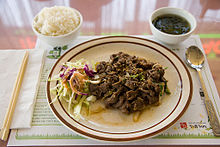- Bulgogi
-
Bulgogi 
Korean name Hangul 불고기 Revised Romanization bulgogi McCune–Reischauer pulgogi Bulgogi (Korean pronunciation: [bulɡoɡi]) is a Korean dish that usually consists of marinated barbecued beef, although chicken or pork may also be used.[1] It is listed at number 23 on World's 50 most delicious foods readers' poll complied by CNN Go in 2011.[2]
Contents
Etymology
Bulgogi literally means "fire meat" in Korean, which refers to the cooking technique—over an open flame—rather than the dish's spiciness. The term is also applied to variations such as dak bulgogi (made with chicken) or dwaeji bulgogi (made with pork), although the seasonings are different.[3]
History
Bulgogi is believed to have originated during the Goguryeo era (37 BC–668 AD) when it was originally called maekjeok (맥적), with the beef being grilled on a skewer.[4] It was called neobiani (너비아니), meaning "thinly spread" meat,[1] in the Joseon Dynasty and was traditionally prepared especially for the wealthy and the nobility class.[5]
Preparation and serving
Bulgogi is made from thin slices of sirloin or other prime cuts of beef.[6] Before cooking, the meat is marinated to enhance its flavour and tenderness with a mixture of soy sauce, sugar, sesame oil, garlic, pepper and other ingredients such as scallions, onions or mushrooms, especially white button mushrooms or shiitake. Sometimes, cellophane noodles are added to the dish, which varies by region and specific recipe.[1][7]
Bulgogi is traditionally grilled, but pan-cooking is common as well. Whole cloves of garlic, sliced onions and chopped green peppers are often grilled or fried with the meat.[1] This dish is sometimes served with a side of lettuce or other leafy vegetable, which is used to wrap a slice of cooked meat, often along with a dab of ssamjang, or other side dishes, and then eaten as a whole.[8]
In modern culture
Bulgogi is served in barbecue restaurants in South Korea and there are bulgogi flavoured fast-food hamburgers sold at many Korean fast-food restaurants. The hamburger patty is marinated in bulgogi sauce and served with lettuce, tomato, onion, and sometimes cheese. It is similar to a teriyaki burger in flavour.[9][10][11]
See also
References
- ^ a b c d (Korean) Bulgogi at Doosan Encyclopedia
- ^ CNN Go Your pick: World's 50 most delicious foods 7 September 2011. Retrieved 2011-10-11
- ^ (Korean) Bulgogi at The National Institute of the Korean Language Dictionary
- ^ The origin of bulgogi, official site of the Ministry of Culture, Sports and Tourism, South Korea.
- ^ (Korean) [1]
- ^ Bulgogi, Korean Spirit and Culture Project
- ^ (Korean) Bulgogi at Encyclopedia of Korean Culture
- ^ (Korean) Bulgogi, Hanwoo Board
- ^ (Korean) Bulgogi burger, Sports Seoul, 2009-06-21. Retrieved 2010-06-27.
- ^ (Korean) Bulgogi burger, Asia Today, 2009-09-11. Retrieved 2010-06-27.
- ^ (Korean) Upgrade burgers, Hankook Ilbo, 2010-06-17.Retrieved 2010-06-27.
- "Bulgogi". The Korean Culture and Information Service (KOIS). Archived from the original on 2008-03-28. http://web.archive.org/web/20080328070054/http://www.korea.net/korea/kor_loca.asp?code=G0704. Retrieved 2008-05-18.
- "Bulgogi". Munhwa Journal. http://mhj21.com/sub_read.html?uid=173§ion=section2§ion2=생활문화. Retrieved 2008-05-18.
External links
- Poular Korean Food | Bulgogi | Grilled Marinated Beef | 불고기
- (Korean) Bulgogi, Korean Cultural Center Los Angeles
- Bulgogi recipe
- Traditional Bulgogi Recipe, Korean-Cooking.com
Categories:- Korean cuisine
- Beef dishes
- Barbecue
- Hawaiian cuisine
Wikimedia Foundation. 2010.

